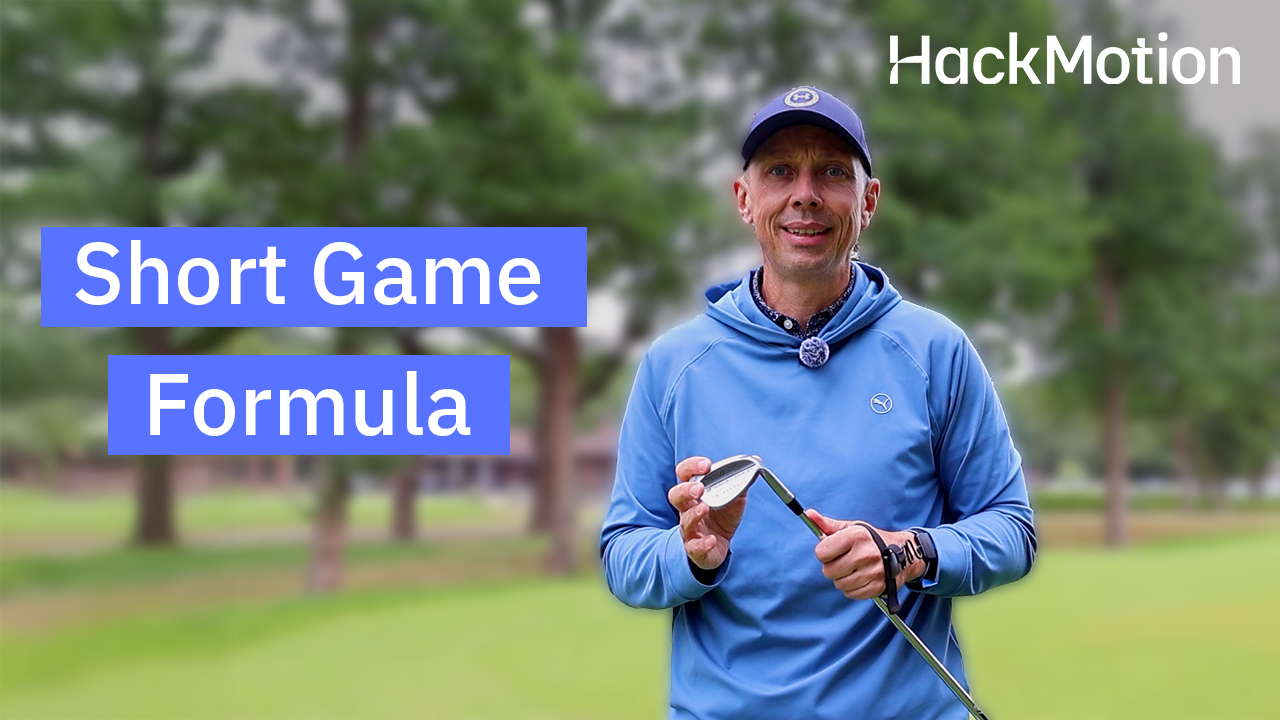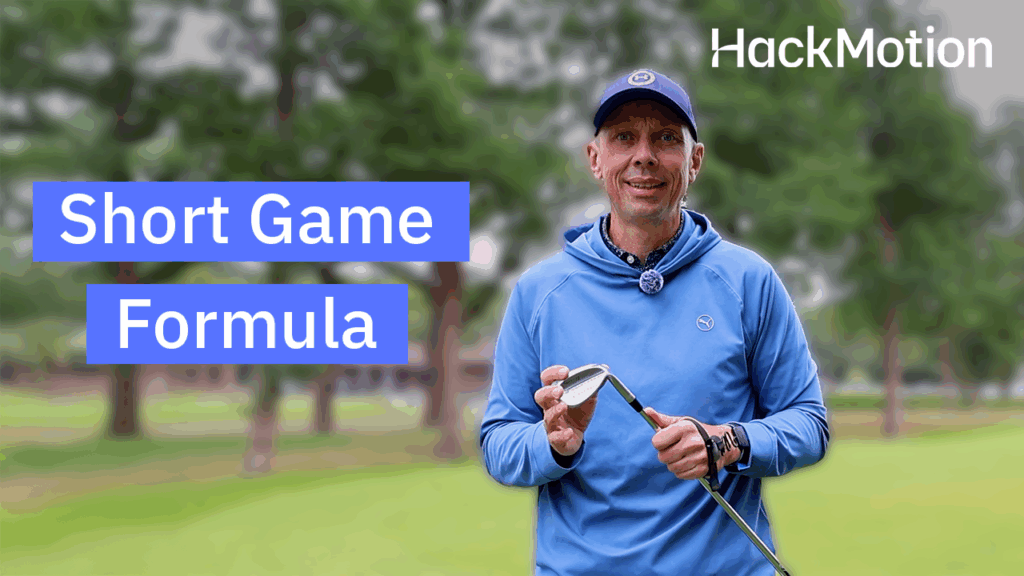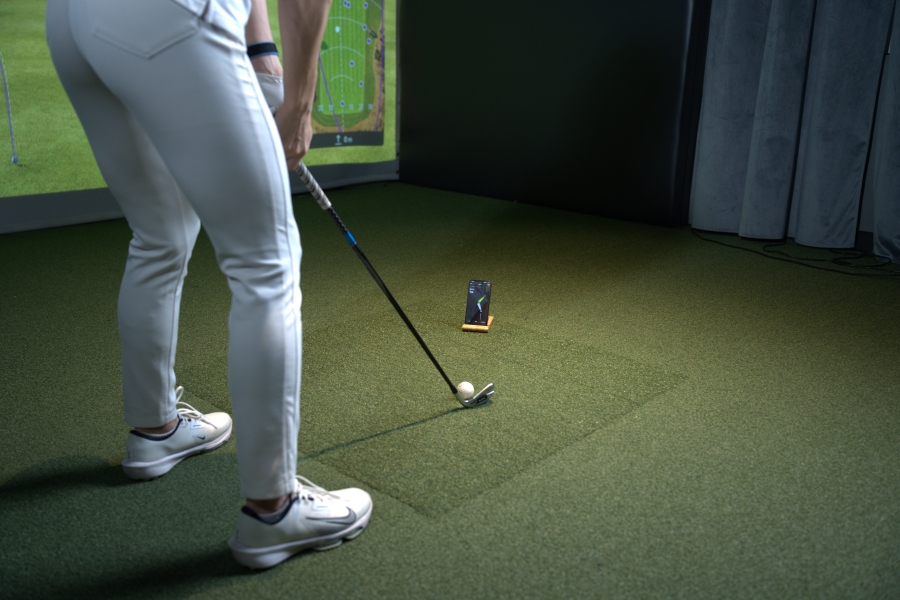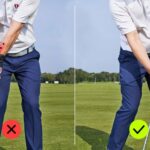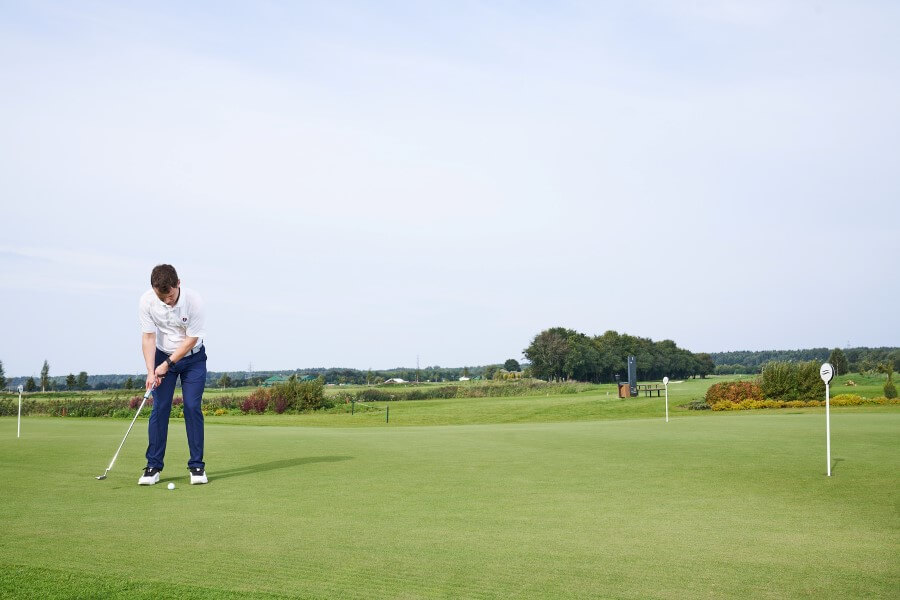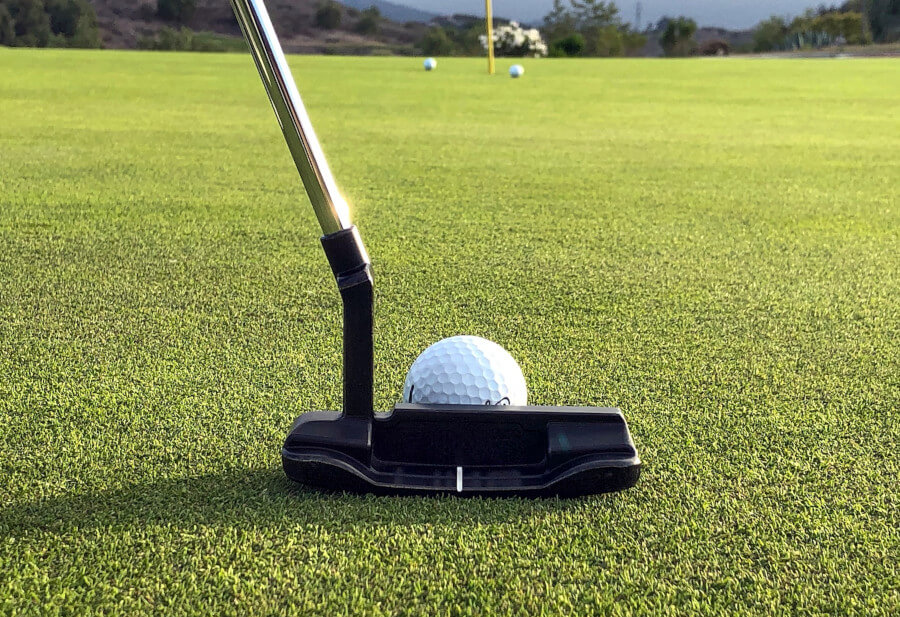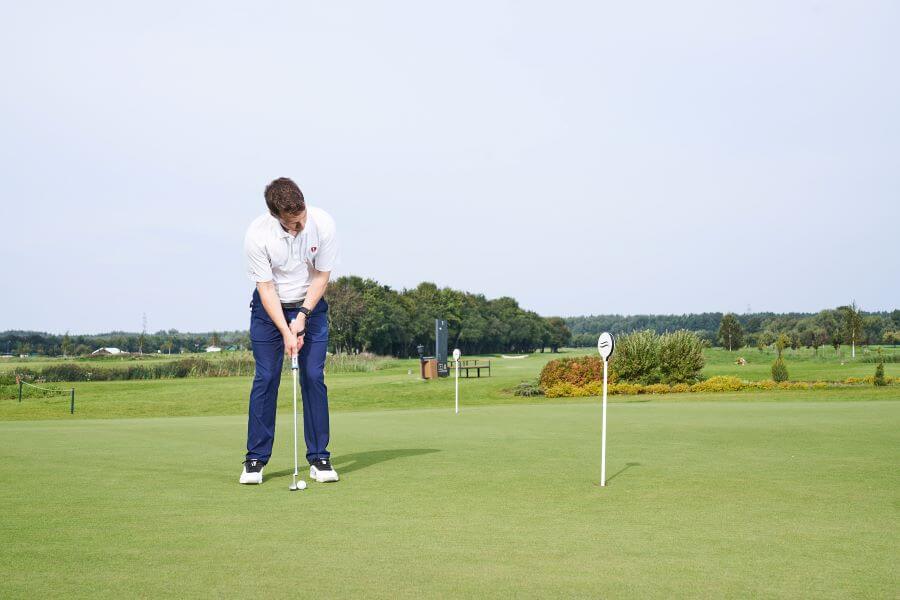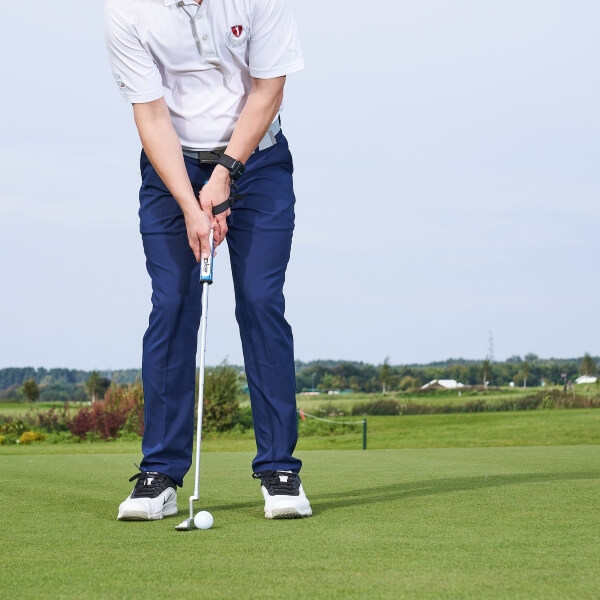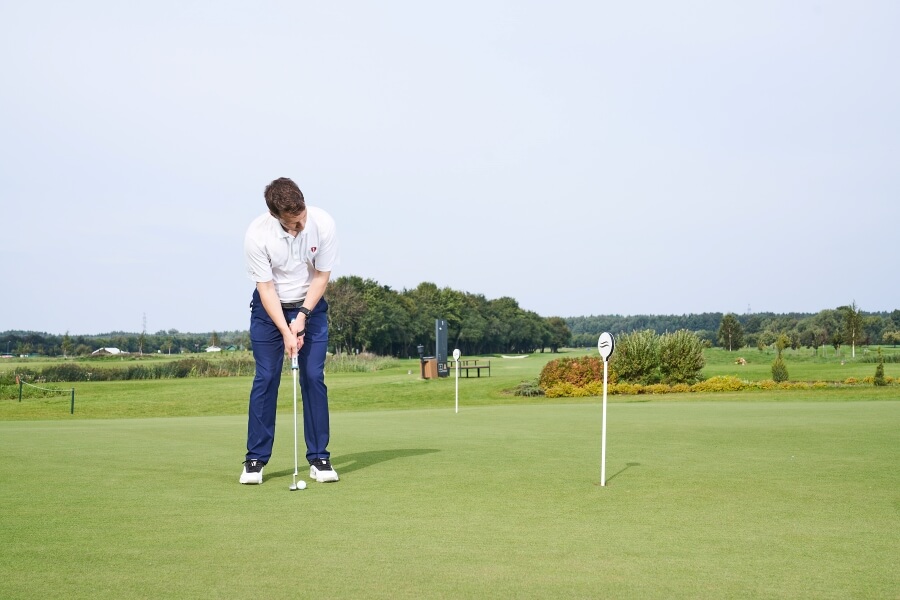How to Hit a Low Chip Shot: 6 Easy Tips & Drills for Consistent Results
Mastering the low chip shot will help any level golfer shoot better scores with minimal effort.
Many amateur golfers overlook this aspect of the game when, the truth is, it’s almost as important as putting, especially for mid-high handicappers.
The tips and drills below will educate you on why this shot is essential while also explaining exactly how to execute the low chip with consistency.
There is also a bonus tip that outlines how to hit a low spinning chip shot, just like you see the pros do on TV.
How to Hit Low Chip Shots (Key Takeaways)
Review these key takeaways before your next practice session. They will give you a basic outline to help you hit lower chips with minimal mechanical changes.
- Adjust your setup to narrow your stance, move your weight forward, and the ball position back.
- Limit wrist involvement and instead keep them quiet to make distance control and ball contact more consistent.
- Ensure the backswing and follow-through mirror each other; if anything, allow the follow-through to be a bit longer.
- Use visualization and planning to judge the landing spot and rollout.
- Use the right club for the shot based on carry distance, break, and green speed.
Contents
6 Simple Tips to Hit Lower Chip Shots Consistently
The low chip shot can be learned quickly with these tips. By using a dependable short game formula, you can add this shot to your arsenal and start lowering your scores immediately.
Adjust Your Setup
Your setup plays a major role in executing a low chip shot. Narrowing your stance is a means to get your weight forward, but it’s important to understand why this is necessary and all the little adjustments that go with it.
- Adopt a Narrow Stance—Position your feet close together, roughly a clubhead’s width apart. A narrow stance helps restrict unnecessary body movement, providing you with greater control throughout your chip shot.
- Position the Ball Back in Your Stance—Place the ball closer to your trailing foot. Positioning the ball back promotes a descending blow and helps the club strike the ball first, rather than the ground.
- Shift Your Weight Forward—Move approximately 60-70% of your weight onto your lead side. Keeping your weight forward encourages a steeper angle of attack, supporting solid contact and discouraging a scooping motion.
Minimize Wrist Action
A significant mistake that amateurs make on low chip shots is not having quiet hands and wrists. Excess wrist hinge often introduces unwanted loft or variability in your strikes, making it difficult to hit the low, controlled shots you want consistently.
Instead, focus on using your shoulders, arms, and core, letting them swing the club in a pendulum motion. Feel as if your wrists are simply along for the ride; they’re not adding to or subtracting from the movement.
Using Hackmotion helps keep your technique repeatable and straightforward, leading to more solid contact and a predictable, low trajectory. The HackMotion will alert you when your wrists become too active and will suggest specific drills to correct your technique immediately.
Control Distance with Swing Length
Applying excessive force can add unwanted energy, causing higher ball flights or inconsistent roll-outs.
For low chip shots, regulate your shot’s power by adjusting the length of your backswing and follow-through, not by swinging harder or faster.
Use a smooth, rhythmic motion, where a shorter backswing means a shorter (and therefore lower and more controlled) chip. Experiment with different swing lengths on the practice green, paying attention to the carry and subsequent roll of the ball.
No matter the length of your backswing, your follow-through should mirror it or be longer to avoid deceleration.
This allows you to develop a feel for how far the ball will travel with each club and swing length, which is essential for getting up and down from various spots around the green.
Visualize the Trajectory and Landing Spot
Every successful low chip starts with a clear plan and mental picture. Before you hit your shot, pick out your ideal landing spot on the green and visualize the ball running and breaking toward the hole, just as you would with a putt.
This visualization helps you commit to the shot and focus your attention, making it more likely you’ll execute your plan.
The low chip requires you to read the green for slopes and speed, since most of the shot’s distance will be covered on the ground. Incorporate a visualization step in your pre-shot routine so you never forget, and give yourself the best chance at a successful chip.
Choose the Right Club
While wedges are often associated with chipping, for a low chip, a less-lofted club could be your best choice.
The lesser loft allows the ball to come out lower and roll more upon landing, resembling a putt’s roll. The higher-lofted clubs tend to pop the ball up, whereas the lower loft helps keep the shot down and rolling toward the target.
- A 7-iron, with its 34-36° loft, produces a very low shot with plenty of roll. This is useful when you have lots of green to work with between you and the hole.
- An 8-iron with 38-40° loft offers slightly more loft and less roll than a 7-iron, yet still keeps the ball low enough for most low chip scenarios.
- A 9-iron and pitching wedge launch the ball a bit higher with less roll, which is not ideal when you want to keep your chip shots low to the ground.
- Avoid defaulting to your sand or lob wedge for every chip; use the loft to your advantage by selecting a lower-lofted club when the situation calls for it.
As you walk up to your shot, analyze the green, particularly the distance from your ball to the green and from the green’s edge to the flag, to make sure that more roll and less airtime is appropriate for the situation.
Practice with different clubs to see which gives you the desired roll for various distances.
Practice Under Pressure and Vary Your Lies
To truly master the low chip, you need to use chipping drills in varied situations, not just from perfect, flat lies.
Challenge yourself by chipping from tight lies, fairway cuts, and different levels of rough—anywhere you might realistically encounter on the course.
Compare your results using HackMotion from a variety of lies to teach you how slight adjustments in setup or club selection affect your ball flight and roll out, making you a more adaptable and confident chipper on the course.
You can also simulate game conditions by competing with friends or setting up “up-and-down” challenges for yourself, where you must get up and down in two shots or less.
This pressure creates a more realistic environment and helps you build trust in your technique when it counts.
How to Hit Low Spinning Chip Shots
The low spinner is much different from a low chip shot. You must be further away from the green to allow for increased club head speed, which produces backspin.
A gap wedge is the ideal club for this shot, but depending on the scenario, you could get away with a pitching wedge or sand wedge.
- First, you need a clean lie, ball, and club face. This creates friction at impact, which will put spin on the ball.
- Your setup will be the same as a low chip shot.
- Keep your hands low during the backswing and through impact into your follow-through; they should never travel above your waist.
- Your hands should also always be ahead of the club head. This is what keeps the trajectory low.
- Lastly, you need a flat or shallow plane. Coming in too steep will just produce a high shot. A shallow plane is what makes the shot difficult because the margin for error on contact is very high.
Drills to Master Low Chip Shots
This short game practice plan and routine covers all the necessary fundamentals needed to hit low chip shots consistently. Choose two to work on each day and alternate between the other two to cover all your bases.
Lead Arm Only Drill
You’ll find the lead arm plays a huge role in keeping the height of your shots down and getting the ball to roll smoothly.
This drill helps with technique but also keeps your tempo in check, as it will allow you to feel the weight of the club head more. This is also great to use as a warm-up routine before rounds.
Lead Arm Only Drill – Step by Step
- Take your normal low chipping setup and address a ball.
- Just before taking your swing, remove your trailing hand from the club and either put it by your trailing pocket or hold the topside of your elbow.
- Initiate your swing while keeping your trailing arm in the same position throughout the swing.
- Only use small swings as this drill is meant to create the sensation of keeping your weight forward and hands ahead of the ball at all times.
Ladder Drill
This is an excellent drill for all chip shots, including lower chips. It trains you to incorporate the proper mechanics while not forgetting about the most important aspect of any short game shot: proper weight.
You can also use this drill with friends to create a little friendly competition.
It’s easy to keep score, and applying a little pressure during your practice will recreate on-course feelings and teach you how to overcome them.
Ladder Drill – Step by Step
- Lay an alignment stick or club down perpendicular to your target line about 10 yards from your starting point.
- Lay another stick down parallel to the first about three yards past it.
- Line your shots up so you will be hitting low chips just to the side of the alignment sticks.
- Hit your first ball so it comes to rest past the first stick but short of the second one.
- Hit your second shot so it comes to rest just past your first ball but still short of the second stick.
- Hit your third ball so it’s past your second ball but short of the second stick.
- The goal is to get as many shots in as possible while following this pattern.
- The game is over when you hit a shot either short of your previous shot or past the second alignment stick.
Plane Chipping Drill
While trajectory is the key to hitting low chip shots, we can’t neglect our alignment and basic fundamentals.
This drill helps keep your technique sharp so you can hit low chip shots consistently and on command. It’s also a great drill to do at home during the off-season or rainy days.
- Video Timestamp: 0:29-2:10
Plane Chipping Drill – Step by Step
- Place a ball down to act as your anchor point.
- Around the ball, you’ll place four water bottles using the ball as the center point.
- The path between the bottles will represent your swing path.
- Swings that deviate from a correct swing path will hit one or more of the water bottles.
Par 18 Drill
This is another great drill to test your nerves and have you ready for the real-life pressures of the golf course.
It will help you adapt to various lies and distances so you can get comfortable executing low chip shots from anywhere. It also incorporates putting to keep practice time from becoming too stale.
Par 18 Drill – Step by Step
- Choose a lie and a hole that requires a low chip shot. The goal is to get the ball up and down in two strokes, one chip and one putt. If you take more, then record it as such.
- Do this 8 more times, choosing 8 different lies to 8 different targets.
- Record your score for each “hole”.
- Play against friends or simply try to beat your score the next time you play.
- Always choose different lies and targets to keep your chipping sharp.
Final Thoughts
Low chipping is a cornerstone of any great short game and is necessary for anyone who wants to shoot better scores consistently.
While it may not be the most exciting part of golf to practice, the benefits far outweigh any boredom caused by practice.
To speed up the learning curve even more, use Hackmotion while performing the drills above.
The advanced system will monitor all aspects of your swing from minor wrist movement to overall tempo and speed. It’s like having a high-level golf coach at your side every step of the way.
